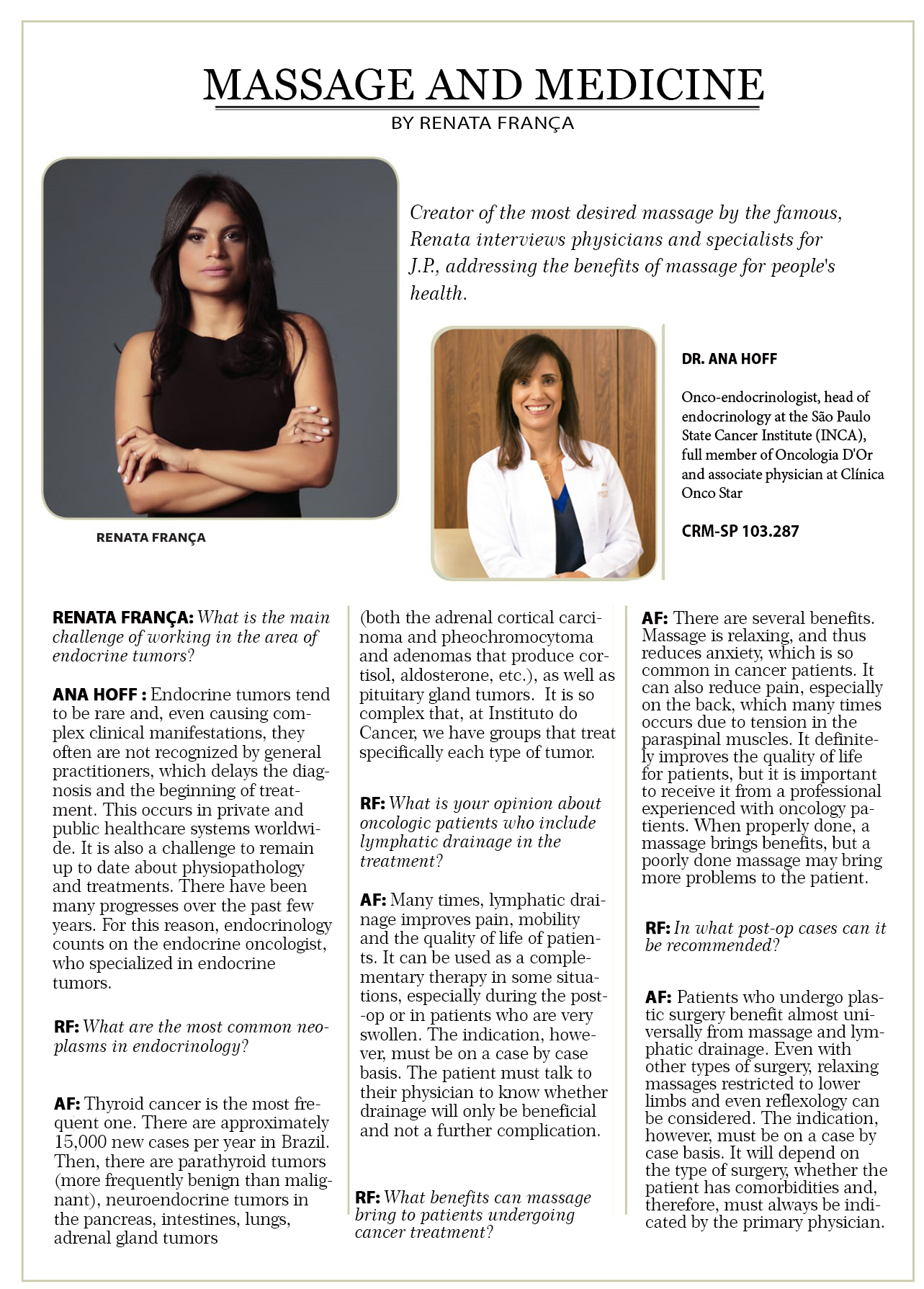
Massage and Medicine by Renata França
Creator of the massage which is the most desired by the famous, Renata interviews physicians and specialists for J.P. magazine, addressing the benefits of massage for people’s health.
Ana Hoff
Onco-endocrinologist, head of endocrinology at the São Paulo State Cancer Institute (INCA), full member of Oncologia D'Or and associate physician at Clínica Onco Star
1- Renata França: What is the main challenge of working in the area of endocrine tumors? Ana Hoff: Endocrine tumors tend to be rare and, even causing complex clinical manifestations, they often are not recognized by general practitioners, which delays the diagnosis and the beginning of treatment. This occurs in private and public healthcare systems worldwide. It is also a challenge to remain up to date about physiopathology and treatments. There have been many progresses over the past few years. For this reason, endocrinology counts on the endocrine oncologist, who specialized in endocrine tumors.
2- RF: What are the most common neoplasms in endocrinology? AH: Thyroid cancer is the most frequent one. There are approximately 15,000 new cases per year in Brazil. Then, there are parathyroid tumors (more frequently benign than malignant), neuroendocrine tumors in the pancreas, intestines, lungs, adrenal gland tumors (both the adrenal cortical carcinoma and pheochromocytoma and adenomas that produce cortisol, aldosterone, etc.), as well as pituitary gland tumors. It is so complex that, at Instituto do Cancer, we have groups that treat specifically each type of tumor.
3- RF: What is your opinion about oncologic patients who include lymphatic drainage in the treatment? AH: Many times, lymphatic drainage improves pain, mobility and the quality of life of patients. It can be used as a complementary therapy in some situations, especially during the post-op or in patients who are very swollen. The indication, however, must be on a case by case basis. The patient must talk to their physician to know whether drainage will only be beneficial and not a further complication.
4- RF: What benefits can massage bring to patients undergoing cancer treatment? AH: There are several benefits. Massage is relaxing, and thus reduces anxiety, which is so common in cancer patients. It can also reduce pain, especially on the back, which many times occurs due to tension in the paraspinal muscles. It definitely improves the quality of life for patients, but it is important to receive it from a professional experienced with oncology patients. When properly done, a massage brings benefits, but a poorly done massage may bring more problems to the patient.
5- RF: In what post-op cases can it be recommended? AH: Patients who undergo plastic surgery benefit almost universally from massage and lymphatic drainage. Even with other types of surgery, relaxing massages restricted to lower limbs and even reflexology can be considered. The indication, however, must be on a case by case basis. It will depend on the type of surgery, whether the patient has comorbidities and, therefore, must always be indicated by the primary physician.
6- RF: In what cases are massage/drainage not recommended? AH: The indication must be on a case by case basis, but I believe a counterindication would be the presence of thrombus in lower limbs. To sum up, massage brings well-being to the patient, improves the quality of life, etc. Therefore, the most important thing to do is contact the physician and ask whether it can be done. In most cases, it can.


